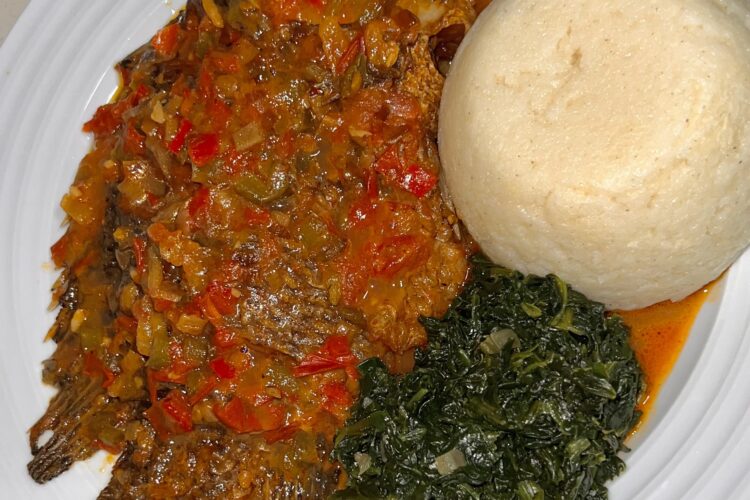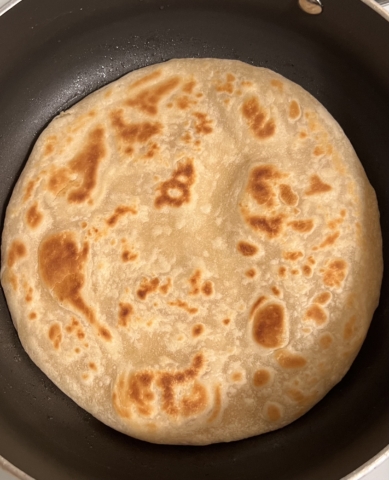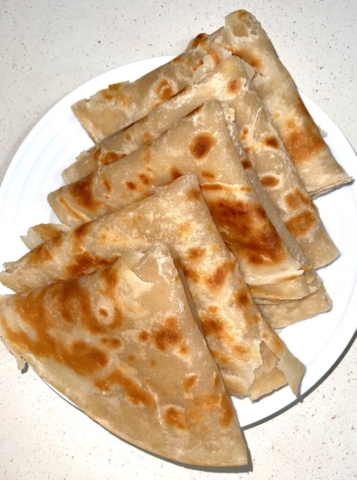This post may contain affiliate links, which means I may receive a commission from purchases made through the links.
East African cuisine can be placed into two broad categories: (1) cuisine that is native to the region, and (2) cuisine that was introduced to the region by other cultures. The former category comprises foods such as matoke, finger millet and its brown ugali, and nyama choma, just to name a few. The latter category comprises foods such as chapati, maize and its white ugali, cassava, pilau, and chai (tea) among others. All these dishes, regardless of whether they originated from other cultures, are integral to East Africa’s food culture and the moment they are mentioned, the bell rings ‘East Africa’ for those who know the region well.
In this article, I give an overview of the dishes that define East Africa as a region. As a Kenyan native myself, I have experienced all of these dishes first-hand and I make them often (some, daily) even as I live thousands of miles away from home. You will notice that I have linked my delicious recipes to some of these dishes so that you can either try them out as you are able or just check them out and learn more about these dishes and how they are made.
Ugali
Ugali is one of the leading staples in East African countries including Kenya, Uganda, Tanzania, Rwanda, Burundi, and the DRC. It is a thick porridge that is made by adding flour to boiling water and stirring until smooth, firm, and fully cooked. Other names for Ugali include sima, nsima, posho, etc. Statistics show that 64% of the population in East Africa consumes Ugali 5 to 7 times a week. Even for those East Africans who live abroad, including myself, many of us prepare ugali frequently in our households. We’ve done our homework and found ways to obtain the best ugali flour out here as well as how to improvise on the equipment needed to make ugali. I wrote this article on how to go about making ugali in America, which I believe could be helpful to all who would love to make this dish away from East Africa.
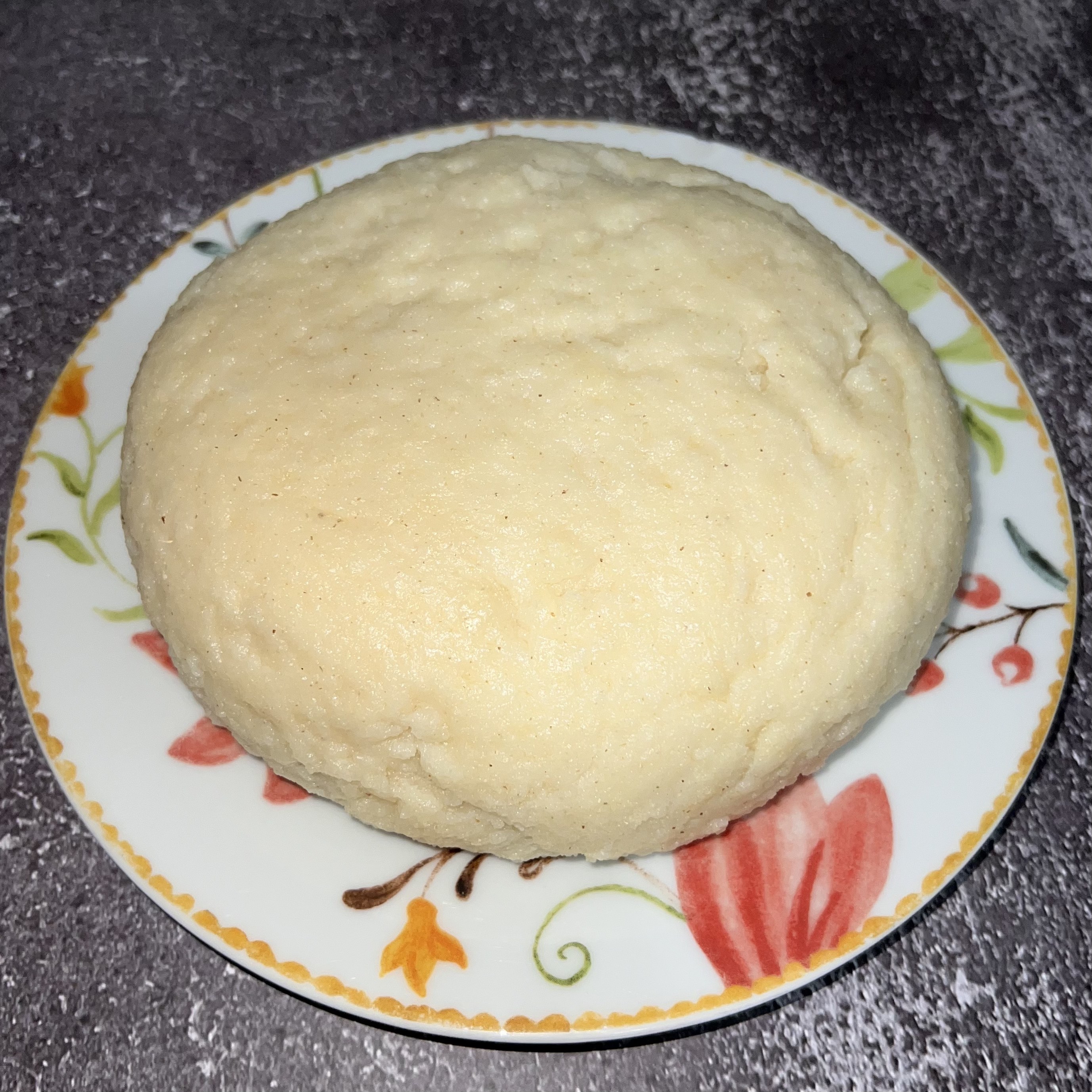
What is Ugali served with?
Ugali being a starchy dish, it is commonly served with a protein, preferably meat, but legumes like beans and green grams might also be used) and leafy green vegetables like sukumawiki (kale), spinach, cabbage, and a wide variety of native vegetables like kunde, managu, saga/saka, mchicha, mirro, mrenda, pumpkin leaves, etc. I discuss some of these vegetables in the later sections of this article. The most common accompaniments for ugali are meat and fish stews, roasted meats, fried meats, and sautéed leafy vegetables.
What are the different types of Ugali?
There are several types of Ugali even though the white one often dominates the internet, making it look like it is the only type of Ugali that exists. Indeed, this white Ugali which is made from white maize (corn) flour is the most popular one across the region. However, Ugali is also made from the flour of tubers like cassava and other grains including finger millet and sorghum. These latter types of ugali, which are commonly referred to as ‘brown ugali’ may feature a single grain, grain combinations, or grain and tuber combinations as I explain in later sections of this article. Brown ugali is more regional and often, each type is preferred by certain specific communities. I, for instance, come from one that widely consumes brown ugali from finger millet only, or a combination of cassava and sorghum.
Cassava in East African Cuisine
Cassava is a popular tuber in East Africa even though it is said to have originated from South America. It is mainly locally grown in East African villages and is consumed in two main ways: (1) directly by either boiling, frying, or roasting, and (2) by processing it to produce flour for ugali. Cassava is known for its drought tolerance properties which make it a valuable crop to have in this region which experiences frequent drought episodes.
The popularity of cassava goes beyond East Africa. Brazilians use cassava to prepare a dish called farinha while in West Africa, especially in Nigeria, it is used to prepare a dish called garri which is closely similar to the ugali that East Africans make. Also, in Thailand, a cassava-based dish called Chueam is popular.
Cassava exists in many varieties, some being sweet and some, bitter, even toxic if not consumed properly. The sweet varieties are the ones that can be boiled and served just like any other starchy dish. However, the bitter and toxic varieties must be properly prepared, e.g., through fermentation, before consumption. Fermentation is the key step in the process of making ugali flour as I explain further below.
What is the process of making cassava flour for ugali?
The process of making cassava flour for ugali is a little more complicated than that of grains, and it is usually done locally by people in the villages. Cassava is harvested when mature, usually about 18 months from the time it was planted. It is then peeled, cut into sizeable chunks, washed, and laid out in the sun for two to three consecutive days. Thereafter, it is fully covered by banana leaves or heavy plastic bags for another three days or so to ferment. Fully fermented cassava is soft, mushy, and covered with (non-toxic) mold. Fermented cassava is then laid out in the sun again for several days until it is fully dry – it appears chalky and easily disintegrates into powder if crushed. At this point, it is ready for grinding to produce flour for ugali.
According to my experience since childhood, dried cassava is hardly ever ground alone to make ugali flour in East Africa. Instead, grains like finger millet and sorghum are incorporated, which increases the nutrient value of the flour as well as reduces the gumminess of cassava, and improves the texture of the ugali.
Finger Millet in East African Cuisine
Finger millet is a grain that is native to East Africa, originating from Ethiopia and Uganda. It is cultivated in many parts of East Africa today although India is now its leading producer. The rate of finger millet production in East Africa has notably gone down over the years owing to its manual and labor-intensive cultivation process in the region. More farmers are preferring to cultivate maize instead.
My family has always cultivated finger millet and my father continues to grow it to this day. Indeed, weeding finger millet is a hands-on job and a slow one at that. My family has never given up on it though because, as I learned growing up, this crop is the traditional food of our community. It is therefore extremely valued. In the past, the Iteso people would hold a ceremony to celebrate the first finger millet harvest of the year.
Finger millet is a valuable crop
Finger millet has many valuable properties. First, it is a drought-tolerant plant. This makes it worthwhile with the current unpredictable weather changes. Secondly, finger millet is a highly nutritious grain. It is rich in protein, dietary fiber, B vitamins, and a range of minerals. The East African communities that cultivate this grain use its flour to make ugali or add the grain to dried cassava before grinding to produce ugali flour that is even more nutritious. Finger millet flour is also used to make porridge, which is a popular breakfast dish across East Africa.
Thirdly, finger millet has one of the longest shelf lives without a need for any preservatives. I remember my Dad telling me just recently, as we were packing some finger millet flour for me to bring with me to the United States, that the flour has a long shelf life, so I should not worry about it going bad quickly. He added that finger millet grains can be stored for more than a decade and they’ll be just fine. I later read the same fact online as I was researching for this article, that this grain can be stored for up to 10 years threshed, and up to 50 years unthreshed! And that is without any preservatives as is the case often with grains like maize which are easily attacked by weevils and other bugs. Quite amazing, right?
Sorghum in East African Cuisine
Like finger millet, sorghum is a grain that is native to Africa and is also commonly grown in East Africa. It is favored by a warm climate thus making East Africa at large an ideal location for growing it. Sorghum is also grown in the United States, Mexico, and India. Sorghum is also rich in protein, dietary fiber, B vitamins, and minerals. The most common use of sorghum as I mentioned earlier is as an addition to dried cassava to make ugali flour. However, some East African communities use pure sorghum or combine it with maize to make ugali flour.
What is the process of making grain flour for ugali?
Maize, sorghum, and finger millet are all harvested when mature and almost fully dry. These grains are further dried at home, then threshed (in the case of maize, milled) and cleaned by winnowing. The clean grains are then ground for flour or packaged into large bags for storage. Storage bags are lined with plastic bags to keep off bugs like weevils. These grains can also be stored unthreshed and only threshed or milled in small amounts for immediate use.
Matoke
Matoke also referred to as ‘matooke’ sometimes, is a dish made from green bananas. These varieties of bananas are harvested when they mature but unripe, and are to be used immediately before they ripen. Bananas are peeled and either cooked whole, cut in halves or chopped into small pieces. The most common ways of cooking these bananas are steaming, boiling, and stewing. Matoke are most popular in Uganda where they are at the heart of every meal. For breakfast, whole bananas are simmered in meat stew, sometimes organ meats, and served with a lot of stock. Lunch or dinner matoke is often served with groundnut sauce or meat stew. Matoke meals are usually very filling.
The process of steaming matoke
As is the case with all other dishes, matoke is more popular in some communities of East Africa than others. For those communities to whom matoke is a staple, the dish has a special method of cooking. After the bananas are peeled, they are carefully arranged in a large cooking pot that is lined thickly with fresh banana leaves. The lining is made thick enough at the bottom of the pan so that when water is added to the pot, it does not come into contact with the bananas. More banana leaves are added at the top to fully wrap the bananas and retain moisture. Bananas are then slowly steamed until fully cooked. When ready, the bananas are skillfully mashed by pressing on the top leaves. The result is a smooth and delicious dish that simply melts in your mouth.
Potatoes in East African Cuisine
Both sweet potatoes are Irish potatoes are commonly used by East Africans. Sweet potatoes are often boiled or roasted and served for breakfast or lunch. Irish potatoes, on the other hand, are popularly used to make fries, known in the region as chips. Irish potatoes may also be stewed alone or added to meat stews and soups and served with rice, matoke, or chapati among other dishes. The Kikuyu people of Kenya are known to use these potatoes in preparing their traditional dish, mukimo, which is a combination of potatoes, maize kernels, and pumpkin leaves boiled and mashed into a meal.
Chapati in East African Cuisine
Chapati is another very popular dish across East Africa and one that undoubtedly defines the region. It is one of those dishes that play all roles. It is served for breakfast, lunch, and dinner, as well as a snack for any time of day. Chapati is a popular street food and is served in restaurants of all calibers, but it is also served on the most honorable occasions such as weddings. It is also one of the most preferred dishes to serve guests who visit East African homes. Most families like to make chapati at home as part of a major meal, and especially for large families. Otherwise, East Africans will grab it from the nearest vendor or restaurant.
Chapati is so popular and such a staple in the region that many East Africans do not know that it was once a foreign dish. History shows that it came to East Africa from India. I will discuss more details on the influence of Indian cuisine on East Africa in a separate article. Despite chapati having come to East Africa from India, it is strongly embraced across East Africa and is loved by all. Follow this link to my recipe for soft and layered chapati.
Pilau in East African Cuisine
Pilau is another dish of Indian origin that is popular in East Africa. It commonly comprises rice, meat, and a mix of spices and seasonings. Variations to the classic East African pilau recipe may include vegetarian pilau or the addition of ingredients like potatoes and peas. Pilau is served to guests on special occasions, sold in restaurants, and features as a street food too.
Maandazi
Maandazi sometimes referred to as mandazi, is a sweet, fried breakfast item that is popular across East Africa. Its closest counterpart in the United States is doughnuts. Maandazi is made with wheat flour, baking powder, sugar, salt, and cooking oil as the basic ingredients. Ingredients like eggs, milk, and butter are often incorporated to further enrich the flavor and nutrition of maandazi. Lemon zest and ground spices like cinnamon and cardamom may also be added to make the maandazi more aromatic. Follow this link for my detailed recipe on the softest and tastiest maandazi. Pictures are also included in the recipe.
Maandazi in East Africa is mostly served with tea for breakfast, but it may also be eaten for lunch or as a snack during any time of day. It is sold in small shops in the rural areas, in the supermarkets in towns and large cities, as well as on the roadsides as street food.
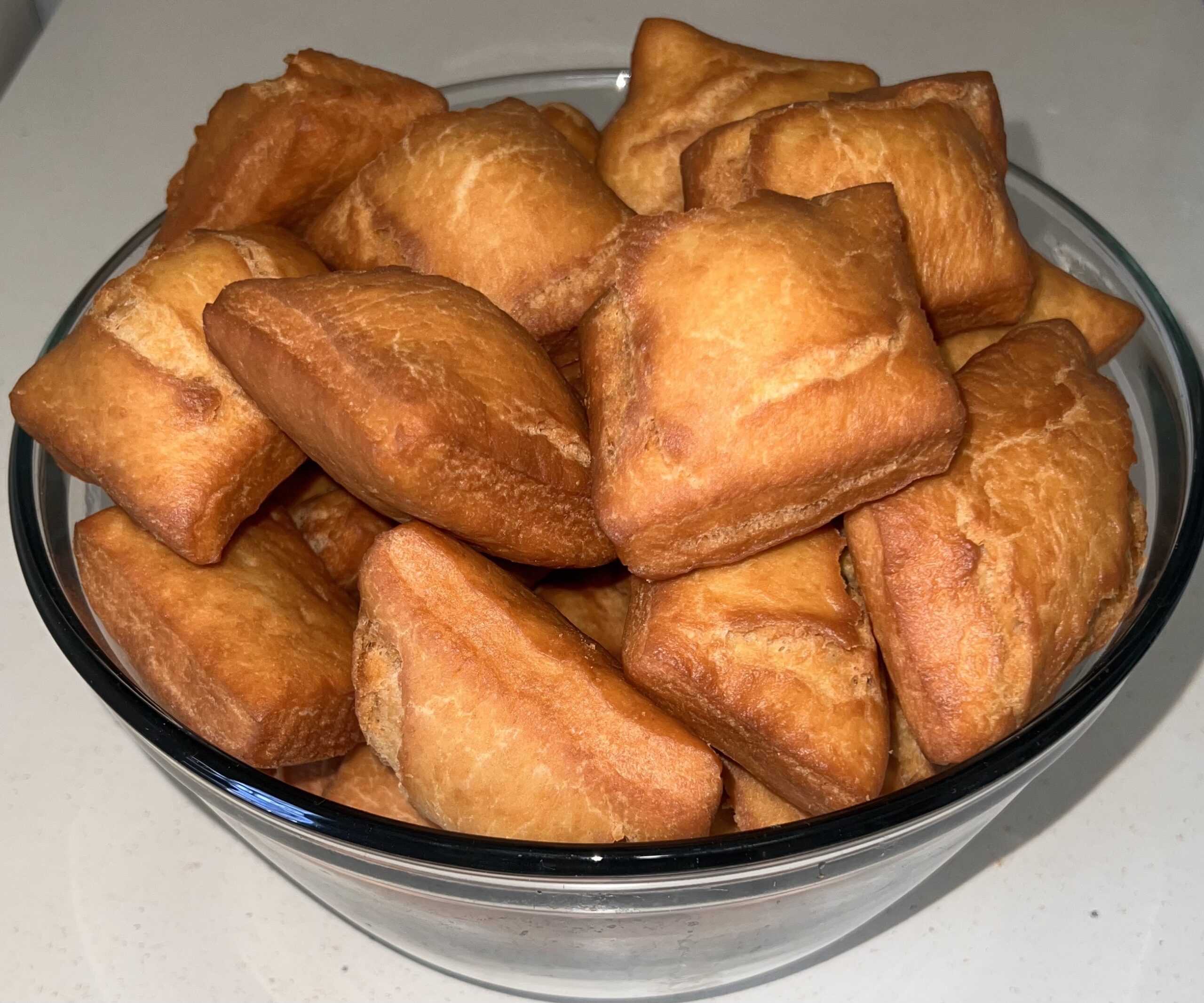
Mahamri
Mahamri is very closely similar to maandazi. While some people use these two terms interchangeably, I have always known the two to be different as I further explain in this recipe for crispy mahamri. Unlike maandazi which is much more popular across East Africa, mahamri tends to be more popular along the Swahili coast. These coastal inhabitants are known for their use of coconut milk in most of their recipes, hence why it is also used in making mahamri. Nevertheless, mahamri is one of the dishes that define East Africa, partly because the dish has significantly spread inland, and partly because the Swahili coast, where this dish is more popular, is an integral part of East Africa’s identity. Other foods that are thought of as coastal but are also foods that identify East Africa as a region are chapati and pilau.
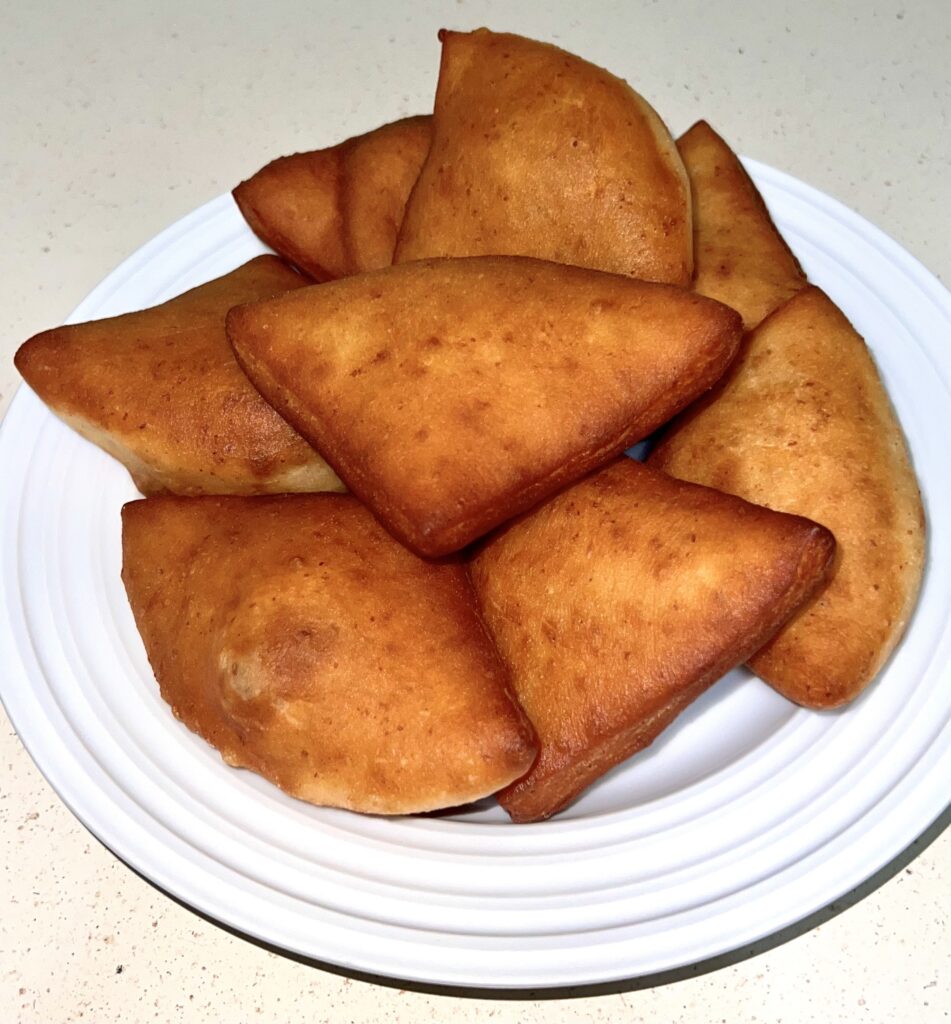
Roasted Maize
Roasted maize is a popular snack in East African countries. This type of maize is harvested when it is still green but fully matured and just about to begin drying. Maize is usually to be roasted soon after it is harvested, otherwise, it loses its sweetness and becomes bland. In Kenya and Uganda, roasted maize is usually made on the roadsides, especially in urban centers, and sold to shoppers and travelers. People roast maize in their households too when it is in season.
Porridge (Uji) in East African Cuisine
Porridge, known in Swahili as uji, is a thick meal made from grain flour. Finger millet flour is the most commonly used for making uji, but corn flour may be used too. Porridge may be likened to grits. It is popular in East Africa, mostly as a breakfast item for people of all ages, and as an infant food. In Kenya, Uganda, and Tanzania, for example, infants and toddlers are commonly fed finger millet porridge several times a day. It is referred to as uji wa wimbi in Kenya and Uganda, and uji wa ulezi in Tanzania. This porridge is the most common weaning food for infants in the region and considering the nutrition profile of finger millet, it is obvious why its porridge is preferred for these purposes. Here is the recipe for finger millet porridge.
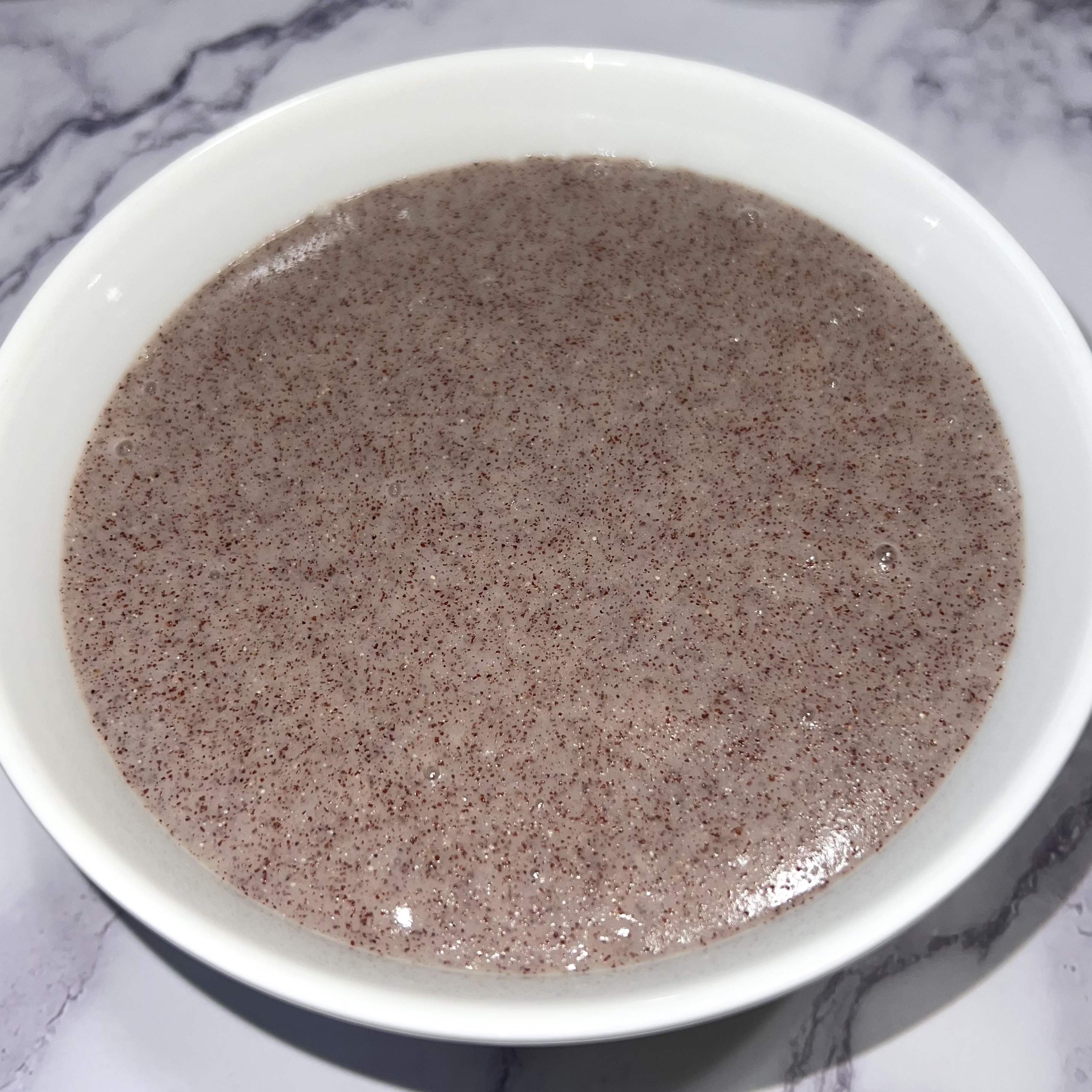
Tea (Chai) in East African Cuisine
Tea with Milk (Chai ya Maziwa)
Tea is central to East African cuisine. The most common way in which East Africans consume tea is with milk and as sweet tea. This tea is usually prepared in a large pot where all the ingredients are added in different stages. They usually include water, milk, loose black tea leaves, and sugar. Spices like cardamom and ginger may also be added for aroma and additional flavor. When the tea is ready, it is sieved and put in a thermos flask from where it is then served. This tea, which I’ve heard being referred to as the African mixed tea, is more popular across East Africa compared to that in which tea bags are added to hot water and/or milk. Please follow this link for the best African mixed tea recipe.
Kenyans love tea very much
I know for a fact that a Kenyan household cannot miss a pack of tea leaves. If it is not KETEPA, then it is Kericho Tea or Baraka Chai. Kenyans are simply obsessed with their tea (myself included) and we take it all the time. It helps that Kenya is a renowned producer of tea, so the supply is always assured. The same applies to other East African countries where besides breakfast, tea is also served at all times of day and to guests when they visit someone at home. In my household, since my childhood, tea has always been after lunch and dinner. Just like Americans love to have coffee after lunch.
As more people are becoming conscious of their sugar intake, it is no longer a common practice to add sugar to tea when making it. Instead, the tea is made sugarless and those who wish to add sugar add it themselves. This allows everyone to add their preferred amount.
Strong tea (Sturungi)
Sturungi is basically sweet black tea. It is mostly served hot in East Africa, unlike in the United States where black tea is served cold. Here is one funny thing about strong tea: East Africans mostly look at it as ‘struggle food’ because people often have it only when they cannot afford milk. Of course, it comes in handy for those who cannot consume dairy milk for health reasons e.g., lactose intolerance. But I would not say that strong tea is a popular drink in East Africa as I have seen here in the United States. You cannot, for example, serve it to a guest without profusely apologizing, unless they specifically asked for it.
To make East African black tea, simply boil water, add loose black tea leaves, sieve into a cup, and stir in sugar. Better yet, place hot water into a mug, add a tea bag, and stir in sugar.
Coffee (Kahawa) in East African Cuisine
Coffee in East Africa is also served as a breakfast item as well as a social drink, especially in the evenings when people converge to chit-chat. But I would say overall in East Africa, it is less popular than tea. Among the communities where coffee is popular are the coastal peoples of Kenya and Tanzania, and some inland communities that grow this crop like the Agikuyu and Ameru of Kenya. Kahawa chungu (bitter [dark roast] coffee) is a very popular concept on the coast of Kenya which has also spread inland, referring to that evening social coffee. The favorable climate for coffee cultivation in Kenya and other East African countries has seen that this region is a renowned coffee producer and exporter.
Groundnuts (Njugu)
Groundnuts are grown in all East African countries and they are popular for their many uses. Roasted groundnuts are served with tea or uji for breakfast in many households. You can also easily grab a pack of any size to snack on from small shops, supermarkets, roadside sellers as well as hawkers. They are simply available and readily accessible in most places across the region. Also, groundnut butter is processed both locally on a small scale and by larger industries and is mostly sold as a bread spread.
Perhaps the one use of groundnuts that is very specific to some communities and not all, is as an ingredient in cooked dishes. Ugandans are well known for using raw groundnut paste and roasted groundnut butter as an ingredient in dishes such as matoke, vegetables, dried meat and fish, and much more. Some communities in western Kenya use it in these ways too but I know of Kenyans who have never tasted these recipes and are even shocked to hear that groundnuts can be used in these ways. That just points to the diversity of cuisine in East Africa.
Sesame (ufuta/simsim)
Sesame, referred to as ufuta in Swahili or sometimes as simsim in Kenya, plays the same roles as groundnuts for the most part. One common use of it as I have observed in the region is to create snacks such as by mixing roasted sesame seeds and nuts and then compacting them using melted sugar. The mixture is made into a bar before the sugar hardens and is cut into pieces which are then sold to consumers.
Other uses of sesame seeds, like those of groundnuts, are as bread spread, and as an ingredient in cooked dishes like vegetables, dried meats, and fish. This, in my experience, is also popular in Uganda and western Kenya. Rather than grind sesame seeds alone, many people in this region prefer to mix them with groundnuts to produce a mixed butter that has a richer flavor.
Roast Meat (Nyama Choma)
Roast meat is a traditional dish in East Africa where many communities are livestock keepers. The Maasai people, who are found in Kenya and Tanzania, are the pioneers of this delicious dish which has now caught on the entire region and can comfortably be classified as a national dish in all East African countries. Nyama choma brings people together to party and have fun. It is commonly made at home but is also readily available for purchase. Nyama choma in Kenya is served everywhere from high-end restaurants to vibanda, the small stalls that sell cheap food. Versions of it, such as mshikaki (grilled meat on skewers) are also sold as street food. In some parts of Uganda, roadside roast meat and mshikaki are so popular among long-distance travelers.
Meat stews in East African Cuisine
Meat stews are integral to East African cuisine. Chicken, beef, and lamb are mostly cut into pieces and cooked into a stew with a good amount of stock included. There are several reasons why stewed meats are preferred. First, it is very suitable to serve with ugali, matoke, mukimo, and other sides which are commonly used in East Africa. Secondly, these meals are often eaten by hand. It is therefore easy to pick up a bite-size piece of the stew without needing cutlery. Thirdly, a small amount of meat, when stewed, can serve more people than grilled or pan-seared meat would, for example. The stock in the stew goes a long way too thus making it convenient for larger families who may not be able to afford a lot of meat frequently. Explore my recipes for beef stew, short ribs stew, and chicken stew.
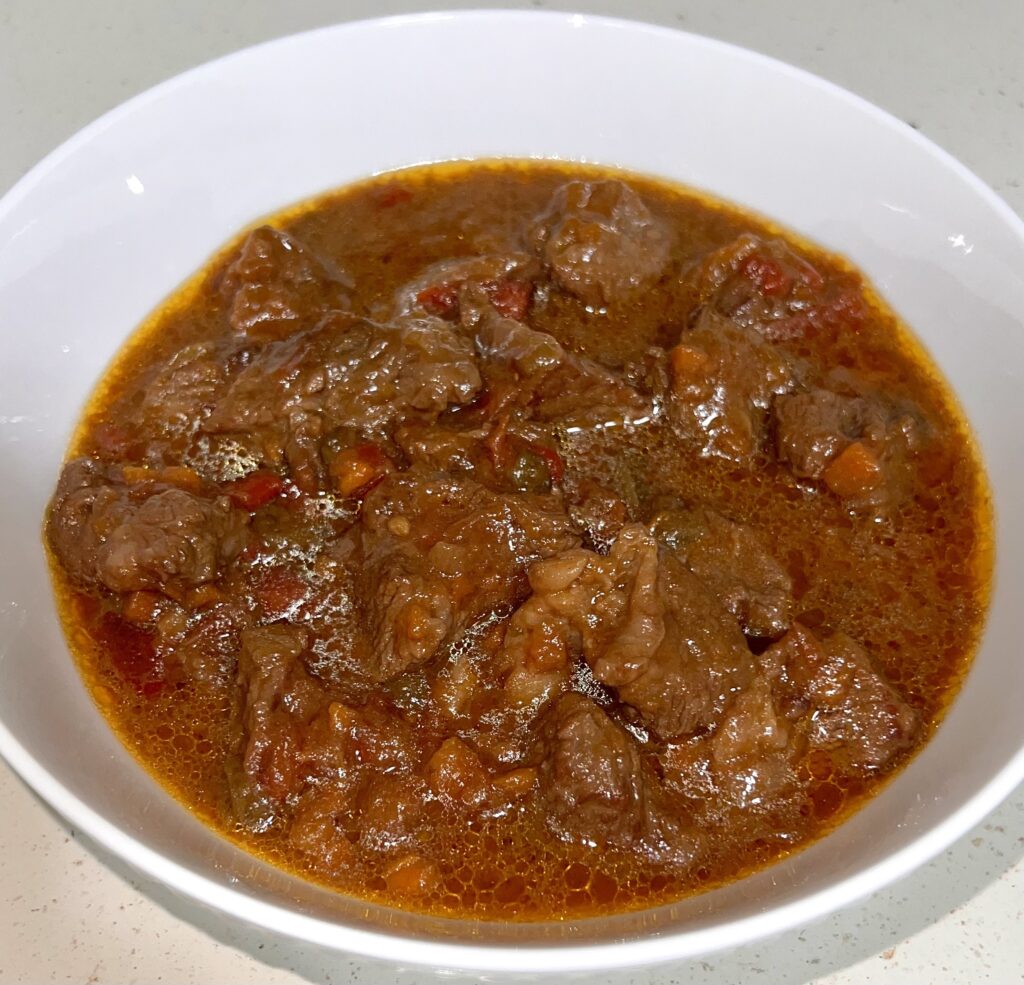
Pork is the only meat that is not usually stewed. Instead, it is fried and served that way because of its high-fat content. Pork in the United States is quite different from that in East Africa, so it calls for different cooking methods too. I came up with this awesome recipe for baking pork back ribs in the oven, which I think you should try too. You are guaranteed to love it.
Fish
The most commonly consumed types of fish in East Africa are Tilapia, Nile perch, Sardines, and Mackerel. While Mackerel is popular in the coastal region, Tilapia and Nile perch are more popular inland, and sardines, known in Swahili as Dagaa, are popular all over. Tilapia is particularly more embraced, I believe because of its great taste, and less strong smell. Unlike in the United States where fish fillet is popular, East Africans like to cook their fish whole. Like meats, fish is also mostly stewed in the region. Fish is often either, dried, smoked, or fried before stewing to ensure a firmer texture and boost its flavor. Check out my recipe for frying and then stewing whole tilapia the Kenyan way.
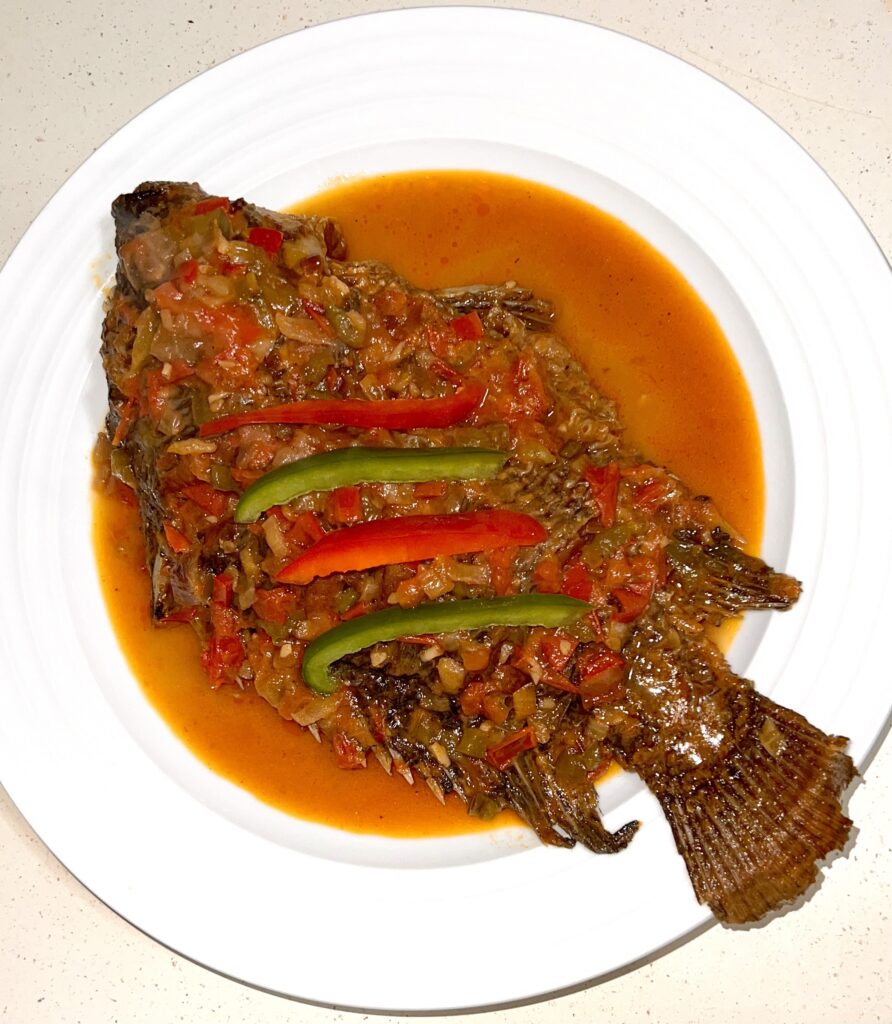
Sukumawiki
Sukumawiki is one of the most popular vegetables in East Africa. It is often likened to collard greens or kale in the United States although it is a different variety from both. The words sukuma wiki literally mean ‘push the week’ and my fellow Kenyans say the vegetable got this name because it is that dish that saves the day when you do not have much, and helps you push the week on. Sukumawiki is commonly served with Ugali. The two make a cheap yet filling meal that is also a staple in East Africa. Of course, many people often include a protein in the mix but when you are stuck, you push your week on with sukumawiki. Check out these two delicious recipes for sukumawiki, (1) sautéed kale with onions, and (2) kale with eggplant and carrots.
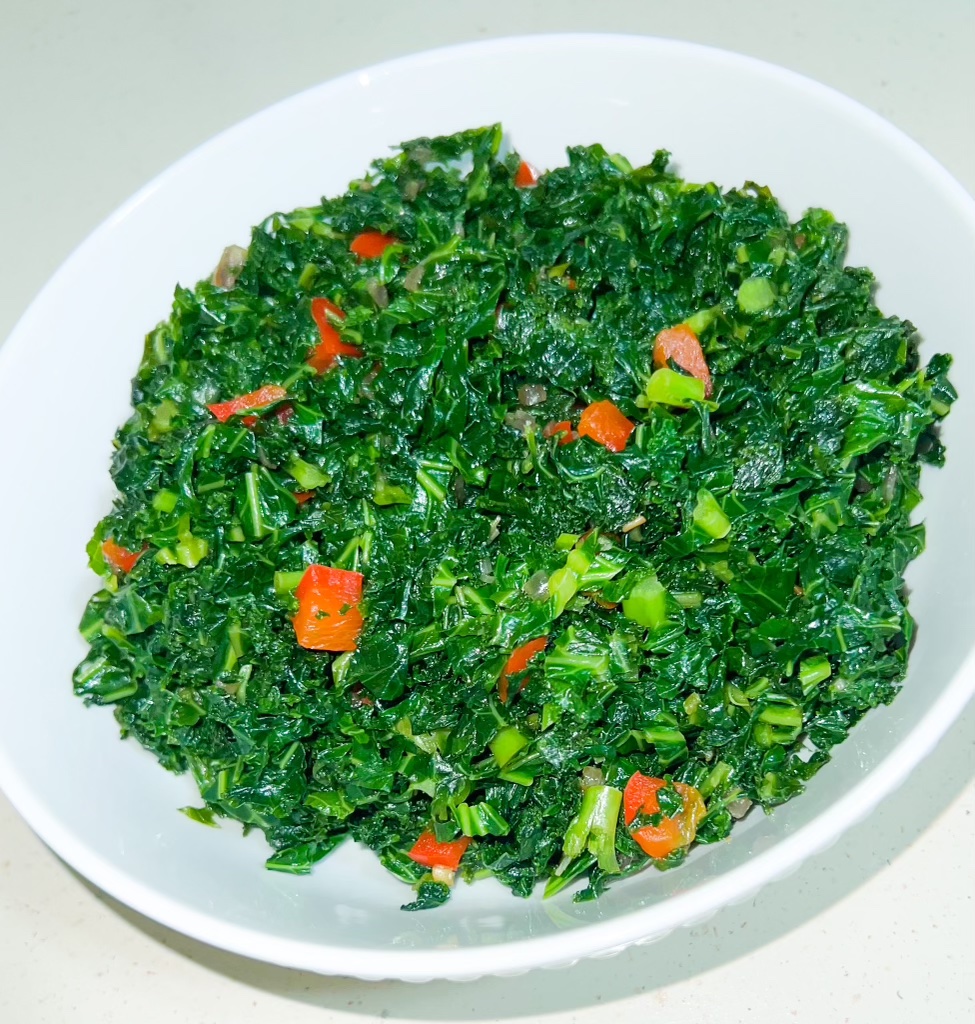
Sukumawiki is a convenient vegetable for large-scale consumption because it is easy to produce on a large scale and it grows quickly. In Kenya, it is the vegetable (other than cabbage) that is preferred in all large institutions, from schools to hospitals and prisons. It is another crop that my family has grown since I was a little girl and supplied to nearby schools.
Cabbage
Cabbage is also widely used in East Africa. It is probably the second most widely used vegetable after sukumawiki. It is the only leafy vegetable that East Africans eat raw in salads. All other vegetables are preferred cooked. Another common way to make it is sauteed cabbage with carrots and bell peppers like I did in this simple recipe.
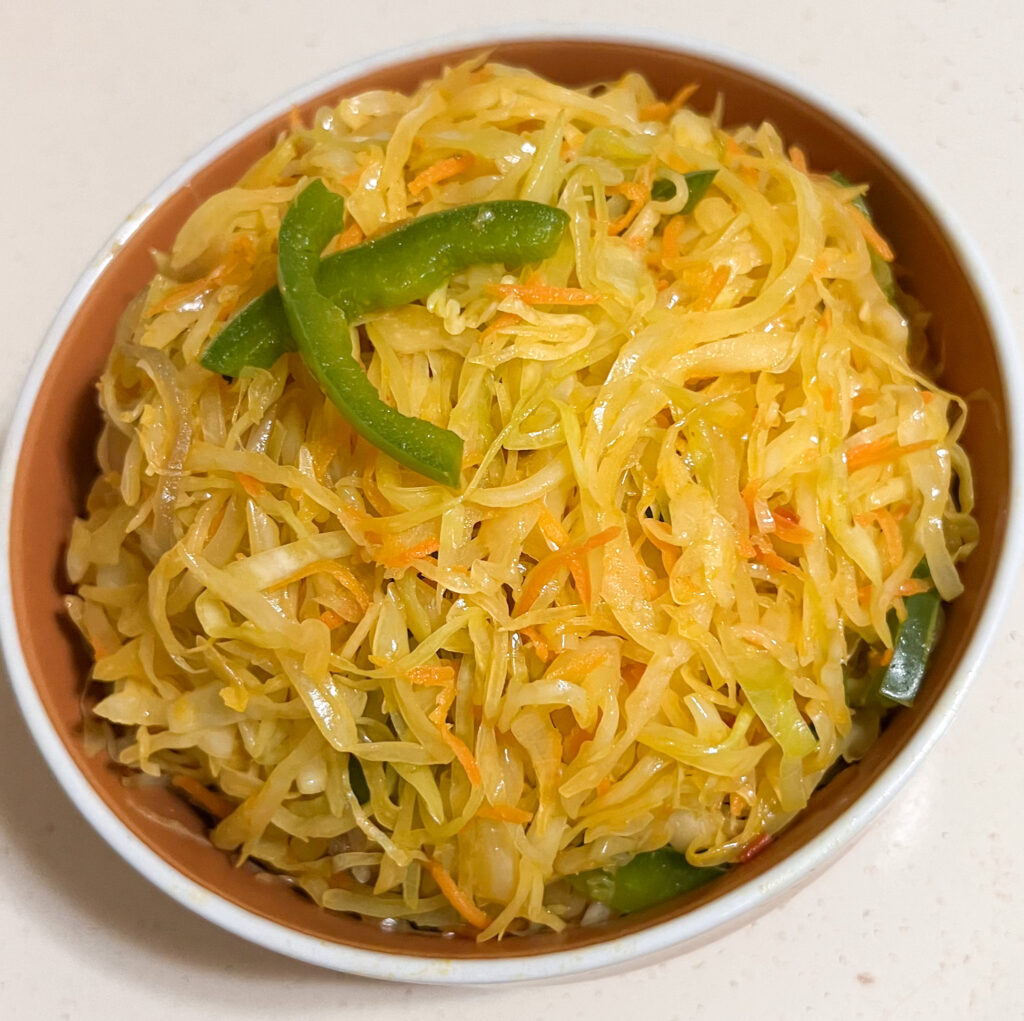
Conclusion
The dishes reviewed in this article identify East Africa as a region. Whether you are simply expanding your knowledge of East Africa or preparing to visit the region, knowing the dishes highlighted here is crucial because they are part and parcel of the lives of East Africans. It is clear that East African cuisine is very diverse and that some dishes, although popular, are more commonly used by some communities than others. Regardless, whatever region you are more interested in, I believe that you may benefit from this article.
